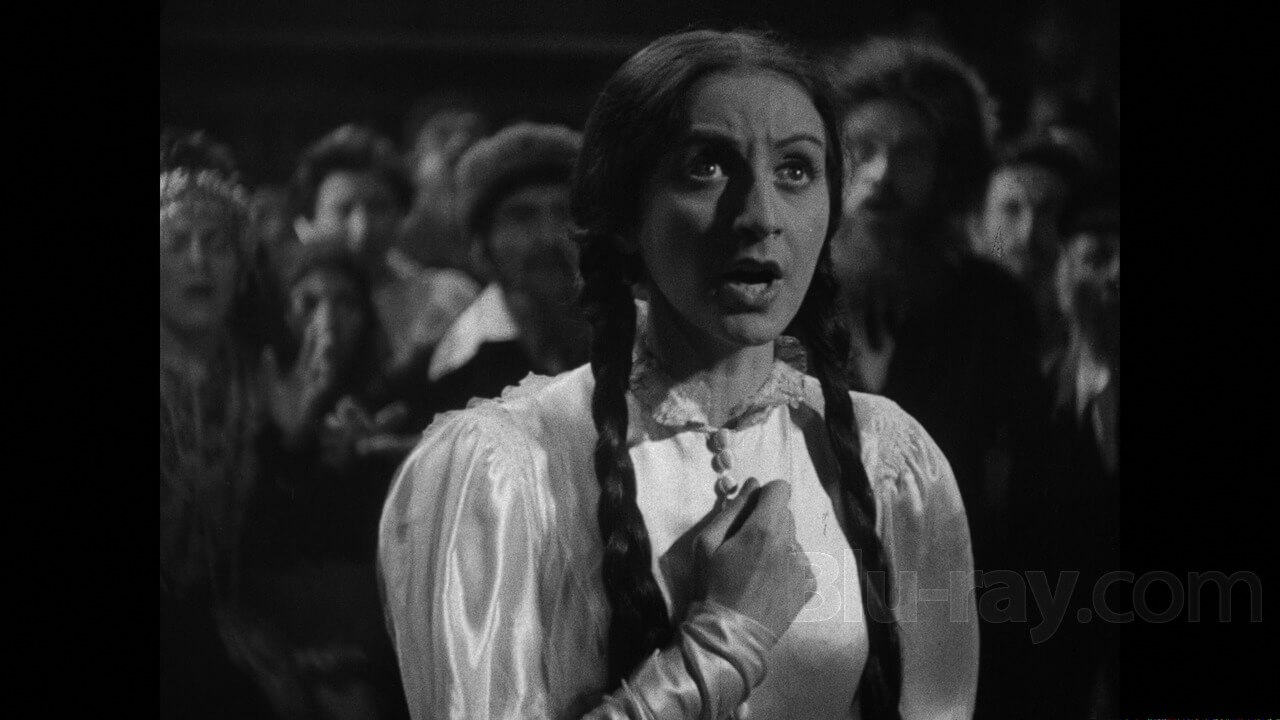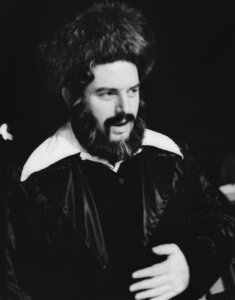How the most influential Jewish play of the 20th century went on to possess the world
For 100 years, ‘The Dybbuk’ has had the demonic power of mesmerizing and galvanizing audiences

A scene from the 1937 filmed version of ‘The Dybbuk.’ Courtesy of Kino-Lorber
The Dybbuk Century: The Jewish Play that Possessed the World
Edited by Debra Caplan and Rachel Merrill Moss
University of Michigan Press, 306 pages, $44.95
Contemporary resonances abound for the century-old play The Dybbuk by S. An-sky, as a new collection of research articles implies. Israeli director Diego Rotman, one of the contributors, even notes that in Hebrew letters, COVID is dybbuk spelled backwards.
Similarly, the drama itself retains an eerie historical-contemporary echo. Its plot tells of a young woman possessed by the spirit of her dead beloved in a 19th century shtetl in the Pale of Settlement, a western region of the Russian Empire where permanent residency by Jews was allowed.
In Jewish folklore dating back at least to the 1500s, a dybbuk is the dislocated soul of a dead person that occupies the body of someone still living. In An-sky’s narrative (spoiler alert!) the young lovers wind up dead, with even more lamenting and morbidity than Shakespeare’s ill-fated Romeo and Juliet.
Small wonder that Rotman decided to stage a 2014 revival of The Dybbuk at Hansen House, a Jerusalem cultural center that was formerly a leprosy hospital. Rotman noted that the play and its theater both represented “performances of abnormal body situations.”
No less innovatively in bodily situations, the Canadian Jewish theater producer Avia Moore offered a 2011 production with an “all-female-identifying cast.” The goal was to raise the issue of gender imbalances in the Yiddish cultural scene. The venue chosen by Moore was also telling; Montreal’s La Sala Rossa, built some 90 years ago by a Jewish workers’ circle to serve as political and recreational center.
As an added attraction for theatergoers, Moore and a colleague baked miniature loaves of challah and placed them on individual tables where audience members sat. Yet even without such tasty noshes, the public has been continually drawn to the play, which the editors of The Dybbuk Century define as “arguably the most influential Jewish play, in any language, of the modern period.”
They also focus on the paradox that, although inspired by An-sky’s ethnographic expeditions into Jewish Eastern Europe, the play is phantasmagoric and lurid, not a literal depiction of Yiddishkeit of its era.
Sometimes likened by critics to Sholem Aleichem’s Tevye the Dairyman stories or paintings by Marc Chagall, The Dybbuk is decidedly more grim than either of these quintessential expressions of Jewish culture. Indeed, a 1937 filmed version of a Yiddish language production directed by Michał Waszyński (born Mosze Waks) features zombie-like village inhabitants, with one garbed as the Grim Reaper, terrifying the bride with a Dance of Death.
This choreographed episode, especially impactful onstage, underlines the essential terpsichorean inspiration of The Dybbuk. Naturally, the American Jewish choreographers, Anna Sokolow, Sophie Maslow and Pearl Lang were enticed by the theme. More ponderous, sedentary versions, like a 2021 semi-staged reading from London’s Almeida Theatre or a 1960 televised US production directed by Sidney Lumet, sometimes miss an essential part of the play’s character, despite their strong points.
Even during An-sky’s lifetime, mavens had reservations about the play. As cultural historian Naomi Seidman admits, The Dybbuk is a “profoundly pessimistic work.” In Revolutionary Russia, the theater guru Konstantin Stanislavski decreed that the play was too downbeat, while Jewish literary salon denizens kvetched that An-sky’s play was over-literary and too stuffed with folklore to be acceptable drama.
Soon after the playwright’s death, productions proved these naysayers wrong. A 1922 Moscow-based Hebrew-language Habima theater version starring Hanna Rovina was one example. Rovnia continued to play the role of the thwarted bride as a near-octogenarian through the late 1960s. Born in present-day Belarus and lauded in Israel as the “First Lady of Hebrew Theater,” Rovina added a further spooky element of Miss Havisham-like grotesquerie not originally envisaged by An-sky.
As researchers currently delve into the complex erotics of the drama, it might be time to respectfully, but candidly, acknowledge that part of the ongoing allure of The Dybbuk is its implicit raunchiness. The Dybbuk Century is also an occasion for reexamining some outstanding creations, as well as overrated ones, which it inspired. The most musically substantial work based on sounds heard at an early production of The Dybbuk was Aaron Copland’s 1928 piano trio, “Vitebsk — Study on a Jewish Theme.”

Copland co-opted a Hasidic nigun from Vitebsk in Belarus that had been interpolated into the Moscow production by composer Joel Engel. Copland’s music evoked a place and time that other composers could not match, although the Jewish musicians George Gershwin, Ernest Bloch, Rudolf Friml and Sigmund Romberg were reportedly hindered from achieving full-scale stage adaptations of The Dybbuk because rights were unavailable.
Copland’s protégé Leonard Bernstein, an overachiever in many categories, produced a 1974 ballet in collaboration with the choreographer Jerome Robbins (born Rabinowitz) that even the most avid Lenny-philes would not claim represented the best accomplishments of either artist. Bernstein’s music was a bit too deliberately clangorous, like soundtrack music relying on mathematical formulas instead of innate melodic impulses.
More intriguing are other Dybbuk offshoots, like a 1997 opera by the Tel Aviv-born Shulamit Ran, which premiered to acclaim at the Lyric Opera of Chicago. Ran’s work is long overdue for rediscovery. Another potential find is the Austrian Jewish composer Robert Starer’s Dybbuk ballet music written in 1960 for choreographers Herbert Ross and Nora Kaye.
A 2007 multimedia chamber opera by Israeli composer Ofer Ben-Amots has been successfully staged internationally, among other versions capturing the multifarious nature of An-sky’s original.
The play’s historical status is undisputed. In 1926, Austrian critics marveled that the touring Moscow Habima production marked the first time ever that the Hebrew language was spoken onstage in Vienna.
The Jewish writer Felix Salten, author of the children’s classic Bambi and the pornographic novel Josefine Mutzenbacher, reviewed the same production in the Neue Freie Presse. Salten concluded that the play’s second act featured a beggars’ dance at a wedding when the characters’ “singing turns into madness and their dance into frenzy.” Audiences, Salten asserted, could sense a “readiness for death and an unbridled thirst for life.”
Indicating the wariness that the play first encountered in Israel, critic Itzhak Norman complained in 1928 that An-sky’s play was “problematic” as a depiction of “age-old sorrows” in the Diaspora. Yet Norman conceded that the power of its dramaturgical multi-tasking brought attendees “closer to the revolutionary spirit of our prophets.” In Norman’s view, a Jew “shouts, converses, dances, sings, and weeps all at the same time – and in this swift and modern action lies all the horror of our era.”
And in 1931, David Goitein, later an Israeli Supreme Court Judge, opined in The Palestine Bulletin that the Habima production redeemed the “poor thing which An-sky had written.” Instead of a dull play that had “bored [him] to death in London,” Gotein proclaimed that The Dybbuk became a “tremendous tragedy” under the aegis of the Habima.
At its centenary, An-sky’s multifaceted, multidimensional Dybbuk remains just that, a “tremendous tragedy” galvanizing audiences worldwide.

















